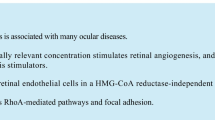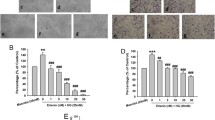Abstract
Purpose
Endothelial-to-mesenchymal transition (EndMT) plays an important role in pathogenesis of a number of inflammatory diseases. Hydroxytyrosol (HT) and, particularly, its major plasma metabolite HT-3O sulfate (HT-3Os) are known olive oil antioxidant and anti-inflammatory polyphenols which exert benefits against vascular diseases by improving endothelial function. However, to date the HT-3Os role in EndMT is not well known.
Methods
To investigate the HT-3Os effects on EndMT in the inflamed endothelium, we used an in vitro model of endothelial dysfunction, challenging endothelial cells (EC), human umbilical EC (HUVEC) and human retinal EC (HREC) with Interleukin-1β (IL-1β), an inflammatory agent. HREC were used as a specific model to investigate HT-3Os effects on vascular retinal diseases.
Results
We found that IL-1β treatment-induced EndMT phenotype in both cell models, also changing cell morphology. HT-3Os protected EC against IL-1β effects, recovering cell morphology and phenotype. Mechanistically, HT-3Os targeting fibroblast growth factor receptor 1 FGFR1 expression and let-7 miRNA, controlled transforming growth factor beta (TGF-β) signalling in EC, downregulating transcription factors expression (SNAI1 and ZEB2) and gene expression of late EndMT markers (FN1, VIM, NOTCH3, CNN1, MMP2 and MMP9).
Conclusion
These results demonstrate that HT-3Os blunts pathological EndMT in inflamed EC, maintaining high let-7 miRNA expression and preventing activation of TGF-β signalling.









Similar content being viewed by others
References
Cao Y, Feng B, Chen S, Chu Y, Chakrabarti S (2014) Mechanisms of endothelial to mesenchymal transition in the retina in diabetes. Investig Ophthalmol Vis Sci 55(11):7321–7331. https://doi.org/10.1167/iovs.14-15167
Souilhol C, Harmsen MC, Evans PC, Krenning G (2018) Endothelial–mesenchymal transition in atherosclerosis. Cardiovasc Res 114(4):565–577. https://doi.org/10.1093/cvr/cvx253
Zeisberg EM, Tarnavski O, Zeisberg M, Dorfman AL, McMullen JR, Gustafsson E, Chandraker A, Yuan X, Pu WT, Roberts AB, Neilson EG, Sayegh MH, Izumo S, Kalluri R (2007) Endothelial-to-mesenchymal transition contributes to cardiac fibrosis. Nat Med 13(8):952–961. https://doi.org/10.1038/nm1613
Dejana E, Hirschi KK, Simons M (2017) The molecular basis of endothelial cell plasticity. Nat Commun 8:14361. https://doi.org/10.1038/ncomms14361
Chen PY, Simons M (2016) When endothelial cells go rogue. EMBO Mol Med 8(1):1–2. https://doi.org/10.15252/emmm.201505943
Chen PY, Qin L, Barnes C, Charisse K, Yi T, Zhang X, Ali R, Medina PP, Yu J, Slack FJ, Anderson DG, Kotelianski V, Wang F, Tellides G, Simons M (2012) FGF regulates TGF-β signaling and endothelial-to-mesenchymal transition via control of let-7 miRNA expression. Cell Rep 2(6):1684–1696. https://doi.org/10.1016/j.celrep.2012.10.021
Bulotta S, Celano M, Lepore SM, Montalcini T, Pujia A, Russo D (2014) Beneficial effects of the olive oil phenolic components oleuropein and hydroxytyrosol: focus on protection against cardiovascular and metabolic diseases. J Transl Med 12:219. https://doi.org/10.1186/s12967-014-0219-9
Peyrol J, Riva C, Amiot MJ (2017) Hydroxytyrosol in the prevention of the metabolic syndrome and related disorders. Nutrients. https://doi.org/10.3390/nu9030306
Estruch R, Ros E, Salas-Salvadó J, Covas MI, Corella D, Arós F, Gómez-Gracia E, Ruiz-Gutiérrez V, Fiol M, Lapetra J, Lamuela-Raventos RM, Serra-Majem L, Pintó X, Basora J, Muñoz MA, Sorlí JV, Martínez JA, Fitó M, Gea A, Hernán MA, Martínez-González MA, For the PREDIMED Study Investigators (2018) Primary prevention of cardiovascular disease with a mediterranean diet supplemented with extra-virgin olive oil or nuts. N Engl J Med 378(25):e34. https://doi.org/10.1056/NEJMoa1800389
Ray NB, Lam NT, Luc R, Bonvino NP, Karagiannis TC (2015) Cellular and molecular effects of bioactive phenolic compounds in olives and olive oil. In: Boskou D (ed) Olive and olive oil bioactive constituents. Elsevier Inc., New York, pp 65–73
Barbieri SS, Eligini S, Brambilla M, Tremoli E, Colli S (2003) Reactive oxygen species mediate cyclooxygenase-2 induction during monocyte to macrophage differentiation: critical role of NADPH oxidase. Cardiovasc Res 60(1):187–197
Scoditti E, Calabriso N, Massaro M, Pellegrino M, Storelli C, Martines G, De Caterina R, Carluccio MA (2012) Mediterranean diet polyphenols reduce inflammatory angiogenesis through MMP-9 and COX-2 inhibition in human vascular endothelial cells: a potentially protective mechanism in atherosclerotic vascular disease and cancer. Arch Biochem Biophys 527(2):81–89. https://doi.org/10.1016/j.abb.2012.05.003
Petroni A, Blasevich M, Salami M, Papini N, Montedoro GF, Galli C (1995) Inhibition of platelet aggregation and eicosanoid production by phenolic components of olive oil. Thromb Res 78(2):151–160
Atzeri A, Lucas R, Incani A, Peñalver P, Zafra-Gómez A, Melis MP, Pizzala R, Morales JC, Deiana M (2016) Hydroxytyrosol and tyrosol sulfate metabolites protect against the oxidized cholesterol pro-oxidant effect in Caco-2 human enterocyte-like cells. Food Funct 7(1):337–346. https://doi.org/10.1039/c5fo00074b
Catalán Ú, López de Las Hazas MC, Rubió L, Fernández-Castillejo S, Pedret A, de la Torre R, Motilva MJ, Solà R (2015) Protective effect of hydroxytyrosol and its predominant plasmatic human metabolites against endothelial dysfunction in human aortic endothelial cells. Mol Nutr Food Res 59(12):2523–2536. https://doi.org/10.1002/mnfr.201500361
Monti M, Hyseni I, Pacini A, Monzani E, Casella L, Morbidelli L (2018) Cross-talk between endogenous H2S and NO accounts for vascular protective activity of the metal-nonoate Zn(PipNONO)Cl. Biochem Pharmacol 152:143–152. https://doi.org/10.1016/j.bcp.2018.03.025
Terzuoli E, Nannelli G, Frosini M, Giachetti A, Ziche M, Donnini S (2017) Inhibition of cell cycle progression by the hydroxytyrosol-cetuximab combination yields enhanced chemotherapeutic efficacy in colon cancer cells. Oncotarget 8(47):83207–83224. https://doi.org/10.18632/oncotarget.20544
Bazzani L, Donnini S, Finetti F, Christofori G, Ziche M (2017) PGE2/EP3/SRC signaling induces EGFR nuclear translocation and growth through EGFR ligands release in lung adenocarcinoma cells. Oncotarget 8(19):31270–31287. https://doi.org/10.18632/oncotarget.16116
Rieder F, Kessler SP, West GA, Bhilocha S, de la Motte C, Sadler TM, Gopalan B, Stylianou E, Fiocchi C (2011) Inflammation-induced endothelial-to-mesenchymal transition: a novel mechanism of intestinal fibrosis. Am J Pathol 179(5):2660–2673. https://doi.org/10.1016/j.ajpath.2011.07.042
Manna C, Galletti P, Cucciolla V, Montedoro G, Zappia V (1999) Olive oil hydroxytyrosol protects human erythrocytes against oxidative damages. J Nutr Biochem 10(3):159–165
Zhang X, Cao J, Zhong L (2009) Hydroxytyrosol inhibits pro-inflammatory cytokines, iNOS, and COX-2 expression in human monocytic cells. Naunyn Schmiedebergs Arch Pharmacol 379(6):581–586. https://doi.org/10.1007/s00210-009-0399-7
Storniolo CE, Casillas R, Bulló M, Castañer O, Ros E, Sáez GT, Toledo E, Estruch R, Ruiz-Gutiérrez V, Fitó M, Martínez-González MA, Salas-Salvadó J, Mitjavila MT, Moreno JJ (2017) A Mediterranean diet supplemented with extra virgin olive oil or nuts improves endothelial markers involved in blood pressure control in hypertensive women. Eur J Nutr 56(1):89–97. https://doi.org/10.1007/s00394-015-1060-5
Chen PY, Qin L, Baeyens N, Li G, Afolabi T, Budatha M, Tellides G, Schwartz MA, Simons M (2015) Endothelial-to-mesenchymal transition drives atherosclerosis progression. J Clin Investig 125(12):4514–4528. https://doi.org/10.1172/JCI82719
Chen PY, Qin L, Tellides G, Simons M (2014) Fibroblast growth factor receptor 1 is a key inhibitor of TGFβ signaling in the endothelium. Sci Signal 7(344):ra90. https://doi.org/10.1126/scisignal.2005504
Kalluri R, Weinberg RA (2009) The basics of epithelial-mesenchymal transition. J Clin Investig 119(6):1420–1428. https://doi.org/10.1172/JCI39104
Elliott GC, Gurtu R, McCollum C, Newman WG, Wang T (2014) Foramen ovale closure is a process of endothelial-to-mesenchymal transition leading to fibrosis. PLoS One 9(9):e107175. https://doi.org/10.1371/journal.pone.0107175
Monti M, Donnini S, Morbidelli L, Giachetti A, Mochly-Rosen D, Mignatti P, Ziche M (2013) PKCε activation promotes FGF-2 exocytosis and induces endothelial cell proliferation and sprouting. J Mol Cell Cardiol 63:107–117. https://doi.org/10.1016/j.yjmcc.2013.07.006
Donnini S, Finetti F, Lusini L, Morbidelli L, Cheynier V, Barron D, Williamson G, Waltenberger J, Ziche M (2006) Divergent effects of quercetin conjugates on angiogenesis. Br J Nutr 95(5):1016–1023
Morbidelli L, Terzuoli E, Donnini S (2018) Use of nutraceuticals in angiogenesis-dependent disorders. Molecules 23(10):2676. https://doi.org/10.3390/molecules23102676
Acknowledgements
This work was supported by MIUR (Ministero dell’Istruzione, dell’Università e della Ricerca)-PRIN (Progetti di Rilevante Interesse Nazionale) (20152HKF3Z) to M.Z.
Author information
Authors and Affiliations
Corresponding authors
Ethics declarations
Ethical standards
The manuscript does not contain clinical studies or patient data.
Conflict of interest
The authors declare that they have no conflict of interest.
Rights and permissions
About this article
Cite this article
Terzuoli, E., Nannelli, G., Giachetti, A. et al. Targeting endothelial-to-mesenchymal transition: the protective role of hydroxytyrosol sulfate metabolite. Eur J Nutr 59, 517–527 (2020). https://doi.org/10.1007/s00394-019-01920-x
Received:
Accepted:
Published:
Issue Date:
DOI: https://doi.org/10.1007/s00394-019-01920-x




